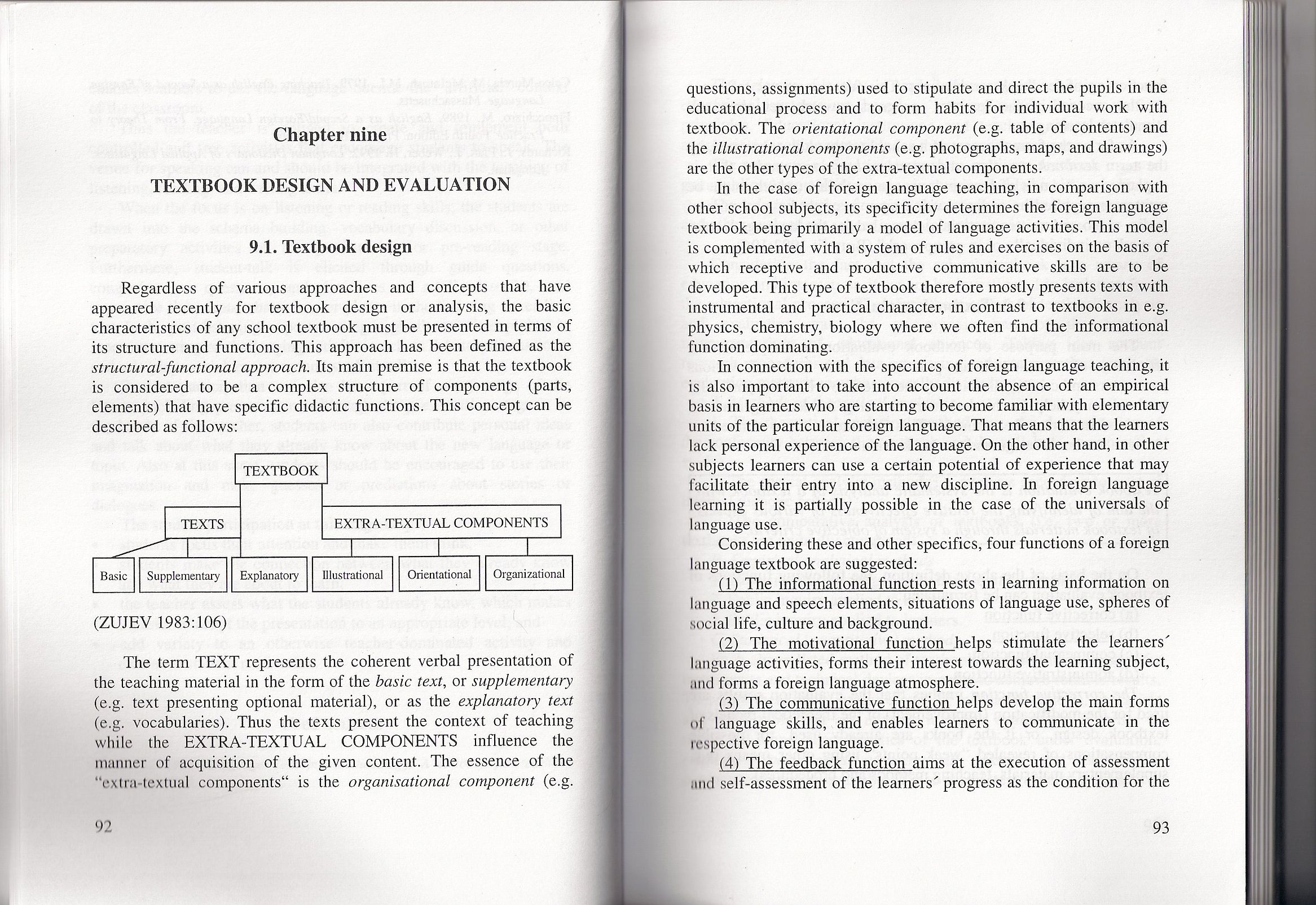skanowanie0046 (8)

Chapter nine
TEXTBOOK DESIGN AND EYALUATION
9.1. Textbook design
Regardless of various approaches and concepts that have appeared recently for textbook design or analysis, the basie characteristies of any school textbook must be presented in terms of its structure and functions. This approach has been defined as the structural-functional approach. Its main premise is that the textbook is considered to be a complex structure of components (parts, elements) that have specific didactic functions. This concept can be described as follows:

(ZUJEV 1983:106)
The term TEXT represents the coherent verbal presentation of the teaching materiał in the form of the basie łext, or supplementary (e.g. text presenting optional materiał), or as the explanatory text (e.g. vocabularies). Thus the texts present the context of teaching while the EXTRA-TEXTUAL COMPONENTS influence the manner of acąuisition of the given content. The essence of the “extra-textual components" is the organisational component (e.g.
ąuestions, assignments) used to stipulate and direct the pupils in the educational process and to form habits for individual work with textbook. The orientational component (e.g. table of contents) and the illustrational components (e.g. photographs, maps, and drawings) are the other types of the extra-textual components.
In the case of foreign language teaching, in comparison with other school subjects, its specificity determines the foreign language textbook being primarily a model of language activities. This model is cpmplemented with a system of rules and exercises on the basis of which receptive and productive communicative skills are to be developed. This type of textbook therefore mostly presents texts with instrumental and practical character, in contrast to textbooks in e.g. physicS, chemistry, biology where we often find the informational function dominating.
In connection with the specifics of foreign language teaching, it is also important to take into account the absence of an empirical basis in leamers who are starting to become familiar with elementary units of the particular foreign language. That means that the leamers lack personal experience of the language. On the other hand, in other subjects learners can use a certain potential of experience that may facilitate their entry into a new discipline. In foreign language learning it is partially possible in the case of the universals of language use.
Considering these and other specifics, four functions of a foreign language textbook are suggested:
(II The informational function rests in learning information on language and speech elements, situations of language use, spheres of social life, culture and background.
(21 The motivational function helps stimulate the leamers' language activities, forms their interest towards the learning subject, und forms a foreign language atmosphere.
(31 The communicatiye function helps develop the main forms of language skills, and enables leamers to communicate in the respective foreign language.
(4) The feedback function aims at the execution of assessment and self-assessment of the leamers' progress as the condition for the
93
Wyszukiwarka
Podobne podstrony:
35791 skanowanie0049 (9) Chapter tenCOMPUTER ASSISTEDINSTRUCTION AND COMPUTER ASSISTED LANGUAGE LEAR
JSIM WorldLabel —Vintage Ijabel Designs Courtesy of Cathe Holden ofJustSomethingIMade.com and WorldI
BAHęESEHIR UNIVERSITY FACULTY OF ARCHITECTURE AND DESIGN DEPARTMENT OF ARCHITECTURE II oiift 10 (III
skanowanie0005 (107) PART ONE Chapter one AIMS AND OBJECTIVES OF FOREIGN LANGUAGE TEACHING 1.0. Term
Wrapping paper and tags 1 Sponge Designs Cut designs out of washing-up sponges and dip them into&nbs
04fig07 = Microsoft Visual Basic - CHAPTER4.MAK [design] ▼ ▲ File Edit View insert fiun lools Ądd-l
04fig10 = Microsoft Visual Basic - CHAPTER4.MAK [design] ▼ ▲ File Edit View insert Bun lools Ądd-ln
05fig10 = Microsoft Visual Basic - CHAPTER5.MAK [design] ▼ File Edit View nsert Bun lools Ądd-lns
05fig11 Microsoft Vistial Basic - CHAPTER5.MAK [design]File Edit View Insert Bun lools Ądd-lns Help
05fig12 = Microsoft Visual Basic - CHAPTER5.MAK [design] ▼ File Edit View nsert Bun lools Ądd-lns
05fig13 Microsoft Vistial Basic - CHAPTER5.MAK [design]File Edit View Insert Bun lools Ądd-lns Help
05fig16 Microsoft Vistial Basic - CHAPTER5.MAK [design] File Edit View Insert Bun lools Ądd-lns Help
05fig17 = Microsoft Visual Basic - CHAPTER5.MAK [design] ▼ ▲ File Edit View insert Bun lools Add-l
więcej podobnych podstron